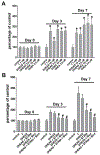Adrenal androgens rescue prostatic dihydrotestosterone production and growth of prostate cancer cells after castration
- PMID: 30807787
- PMCID: PMC6438375
- DOI: 10.1016/j.mce.2019.02.018
Adrenal androgens rescue prostatic dihydrotestosterone production and growth of prostate cancer cells after castration
Abstract
Adrenal androgens dehydroepiandrosterone (DHEA) and DHEA-sulfate (DHEAS) are potential substrates for intracrine production of testosterone (T) and dihydrotestosterone (DHT), or directly to DHT, by prostate cancer (PCa) cells. Production of DHT from DHEAS and DHEA, and the role of steroid sulfatase (STS), were evaluated ex vivo using fresh human prostate tissue and in vitro using human PCa cell lines. STS was expressed in benign prostate tissue and PCa tissue. DHEAS at a physiological concentration was converted to DHT in prostate tissue and PCa cell lines, which was STS-dependent. DHEAS activation of androgen receptor (AR) and stimulation of PCa cell growth were STS-dependent. DHEA at a physiological concentration was not converted to DHT ex vivo and in vitro, but stimulated in vivo tumor growth of the human PCa cell line, VCaP, in castrated mice. The findings suggest that targeting metabolism of DHEAS and DHEA may enhance androgen deprivation therapy.
Keywords: Adrenal androgen; Androgen; Intracrine androgen metabolism; Metabolism; Prostate cancer; Steroid sulfatase.
Copyright © 2019 Elsevier B.V. All rights reserved.
Conflict of interest statement
Conflict of interest: The authors declare no potential conflicts of interest.
Figures






Similar articles
-
Steroid Sulfatase Stimulates Intracrine Androgen Synthesis and is a Therapeutic Target for Advanced Prostate Cancer.Clin Cancer Res. 2020 Nov 15;26(22):6064-6074. doi: 10.1158/1078-0432.CCR-20-1682. Epub 2020 Sep 14. Clin Cancer Res. 2020. PMID: 32928794 Free PMC article.
-
Androgens, adrenal androgen precursors, and their metabolism in untreated primary tumors and lymph node metastases of human prostatic cancer.Am J Clin Oncol. 1988;11 Suppl 2:S30-6. doi: 10.1097/00000421-198801102-00008. Am J Clin Oncol. 1988. PMID: 2853935
-
Effect of castration monotherapy on the levels of adrenal androgens in cancerous prostatic tissues.Steroids. 2011 Feb;76(3):301-8. doi: 10.1016/j.steroids.2010.12.001. Epub 2010 Dec 13. Steroids. 2011. PMID: 21147140
-
Advantages of total androgen blockade in the treatment of advanced prostate cancer.Semin Oncol. 1988 Apr;15(2 Suppl 1):53-61. Semin Oncol. 1988. PMID: 3285484 Review.
-
Beyond T and DHT - novel steroid derivatives capable of wild type androgen receptor activation.Int J Biol Sci. 2014 Jun 3;10(6):602-13. doi: 10.7150/ijbs.8844. eCollection 2014. Int J Biol Sci. 2014. PMID: 24948873 Free PMC article. Review.
Cited by
-
Dehydroepiandrosterone Supplementation Results in Varying Tissue-specific Levels of Dihydrotestosterone in Male Mice.Endocrinology. 2022 Oct 23;163(12):bqac163. doi: 10.1210/endocr/bqac163. Endocrinology. 2022. PMID: 36201601 Free PMC article.
-
Glucocorticoids are induced while dihydrotestosterone levels are suppressed in 5-alpha reductase inhibitor treated human benign prostate hyperplasia patients.Prostate. 2022 Oct;82(14):1378-1388. doi: 10.1002/pros.24410. Epub 2022 Jul 12. Prostate. 2022. PMID: 35821619 Free PMC article.
-
Recapitulation of prostate tissue cell type-specific transcriptomes by an in vivo primary prostate tissue xenograft model.PLoS One. 2020 Jun 25;15(6):e0233899. doi: 10.1371/journal.pone.0233899. eCollection 2020. PLoS One. 2020. PMID: 32584883 Free PMC article.
-
Components of the human-specific, p53-mediated "kill switch" tumor suppression mechanism are usurped by human tumors, creating the possibility of therapeutic exploitation.Cancer Drug Resist. 2019 Dec 19;2(4):1207-1214. doi: 10.20517/cdr.2019.89. eCollection 2019. Cancer Drug Resist. 2019. PMID: 35582271 Free PMC article.
-
Differential Associations of SLCO Transporters with Prostate Cancer Aggressiveness between African Americans and European Americans.Cancer Epidemiol Biomarkers Prev. 2021 May;30(5):990-999. doi: 10.1158/1055-9965.EPI-20-1389. Epub 2021 Feb 22. Cancer Epidemiol Biomarkers Prev. 2021. PMID: 33619025 Free PMC article.
References
-
- Wilson EM and French FS, 1976. Binding properties of androgen receptors. Evidence for identical receptors in rat testis, epididymis, and prostate, J Biol Chem 251, 5620–9. - PubMed
Publication types
MeSH terms
Substances
Grants and funding
LinkOut - more resources
Full Text Sources
Medical
Research Materials

